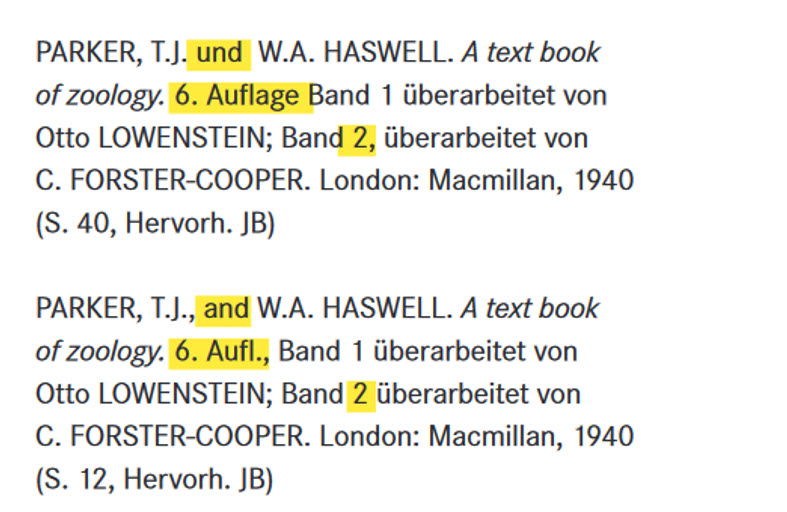
A Look at Why Attempts So Far Have Failed
If you travel to Germany and order a beer, you might notice that the glass has a line on it. This is the “Füllstrich”, which can be translated literally as “fill line”. The line is not just decoration – it’s required by law, and wherever beverages are sold, the amount of liquid served needs to be within a certain proximity of the line. Laws like these show that the cliché of Germany being an especially rule-loving country does have some truth to it.
So, you might expect that this predilection would extend to academia and that you would find standard rules for citation at German universities. For one thing, it would make a lot of sense: there would only be one style manual necessary, which would make it more efficient to work together in a team of authors, share source information, and find cited publications. Also, internationally it does seem that there’s recently been more of a trend towards adopting a well-known style rather than developing entirely new guidelines. In the last few years, the Citavi team has seen several major journal publishers switch all of their publications’ individual style guidelines over to APA format, a style that we examined in detail in a recent blog post. In universities the rate of standardization is harder to measure, but at least in the United States, undergraduate students tend to be taught just a handful of styles: APA, MLA, Chicago, and Vancouver are some of the most common ones.
And in Germany, where most Citavi users are located? It might surprise our international readers to learn that compared to the U.S., the situation in Germany is a bit more chaotic. The main reason is that it’s commonplace for individual universities, departments, or professors to create their own citation style guidelines. These rules are rarely as fleshed out with as many examples and guidance as a larger publication manual such as APA or MLA. In addition, they frequently contain inconsistencies, confusing rules, and sometimes even idiosyncratic requirements not seen in other citation styles.
As a result, there’s a lot of confusion surrounding the practice of citation, which our support team sees firsthand from the many German students who contact us on a daily basis. The worst part is that citation styles even within the same discipline can vary a great deal. And if a student decides to change her course of studies, she’ll quickly find that all the rules she learned no longer apply.
You could ask yourself why professors at German universities would go to all of this trouble to develop custom style rules when adopting a more widely used citation style would mean less confusion and ambiguity for everyone involved. And you wouldn’t be the only one. In fact, there have been a few attempts at standardizing citation in Germany over the years. So, will these citation styles lead to more unified citation methods in the future? That’s the question we’ll seek to answer below.
The DIN 1505 Citation Style
The Deutsche Institut für Normung, or “DIN” for short, is the national standardization organization for Germany, and, like any standards organization, it draws up wide-ranging standards for anything from paper size to robot safety guidelines to construction requirements. A committee of subject experts decides on the standards, which are then published and can be purchased from the institute. The word “standard” can be a bit misleading, since DIN guidance can be seen as having the “nature of a recommendation” rather than being a hard and fast rule (Klein 2001, p. 14).
The second part of the DIN 1505 standard entitled “Bibliographic references to documents: rules for citing” from 1984 covers how documents should be cited and how bibliography entries should be formatted. The standard has the goal of making it easier to identify documents and obtain them more easily. Its description patterns are designed as an aid for more easily identifying different types of sources and then being able to cite them appropriately (Lorenzen 1997).
The rules described in the standard are similar to the cataloging rules used by German libraries at the time it was developed (Wiesenmüller 2004, p. 169). It’s thus very likely the standards panel was primarily made up of librarians. The punctuation rules support this: for example, a space before a colon is uncommon in German citation practices – but in the German library world at that time it was common.
During my studies at the Stuttgart Media University around 6 years ago, I remember Professor Wiesenmüller offering her appraisal of the style during one of my courses. Her assessment back then was that DIN 1505 was not widely used, a situation which unfortunately has not changed in the meantime.
The DIN ISO 690 Style
If the dream of having one national style is nice, how much better would it be to have one style used all over the world? The ISO 690 standard is an attempt to do just that.
The International Organization for Standardization (ISO) has been publishing international standards since 1946. Today, the independent, non-governmental organization is comprised of members from 164 countries. As a partner institution, DIN sends delegates to the international standards organization.
The first attempt at an international citation standard was issued in English in 1975. The most recent edition is ISO 690:2010 published 10 years ago. The standard has since been translated into other languages. For example, in French the style is known as “Norm NF ISO 690-2010”. In German, the style name is “DIN ISO 690”, and it has supplanted the former DIN standard 1505 discussed above. A version with additional information for citing electronic reference types was released in 2013, so the most current version is DIN ISO 690:2013-10 Information and documentation – Guidelines for bibliographic references and citations to information resources.
Let’s take a closer look at DIN ISO 690:2013-10. It describes three different citation methods.
- Name and date: In-text citations use the authors’ last names and the year of publication. The bibliography is sorted alphabetically.
- Numeric: In-text citations use numbers in parentheses. The citations are numbered in the order cited. The corresponding number can then be found in the bibliography with the full source information. The bibliography is sorted according to the order in which the references were cited and not alphabetically.
- Running notes: In-text citations use numbers. The corresponding numbers can then be found in the notes with full source information. The notes are sorted according to the order in which the references were cited and not alphabetically.
This all sounds well and good, but the execution unfortunately is not as flawless as you might expect from a standard. For example, in a recent analysis of the DIN ISO 690 guidelines, Bertram (2019) found a number of inconsistencies. These include:
- Inconsistent formatting of names
- Use of different date formats
- ISSN information (the standard number for a journal) in addition to the DOI
In addition, she discovered one example that was used inconsistently in two different places in the standard:

Figure: Bertram 2019, p. 222
Based on the style’s inconsistent rules and errors in translation and punctuation, Bertram concludes that the style does not fulfill its aims as a citation guide.
The Citavi team has a similar opinion of the style. Its guidance is ambiguous, incomplete and contradictory. In other words, the style is the opposite of what one would expect from any citation style guidelines, much less a work that claims to be standard. Of course, the style itself may not have had these aims. The description of the English-language style on the ISO website contains the following disclaimer “ISO 690:2010 does not prescribe a particular style of reference or citation. The example used in ISO 690:2010 are not prescriptive as to style and punctuation.”
DIN ISO 690 doesn’t even contain guidance for all reference types. For example, legal reference types are excluded. Perhaps most ironically, the standard doesn’t even include an example for how to cite a standard!
But do People Use It…?
Despite the style’s issues, our statistics show that the style DIN ISO 690 (Author-Date) is one of the top ten most used citation styles in Citavi. Google Scholar and other databases also include an option for exporting a citation in the DIN ISO 690 format. So, the style does seem to be used regularly in practice.
At German universities the style still does not seem to be as widely used as one might expect for a standard, though. We expect that this is due to the lack of clear prescriptive guidelines. Since the examples are contradictory or encompass different variations, instructors prefer to formulate their own citation rules. In addition, the standard costs quite a bit compared to guidelines from other publishers. This may deter universities from purchasing it and/or using it on a more widespread basis.
As the DIN ISO 690 standard is now 7 years old, the standards committee might soon consider updating the style. The English-language standard ISO 690 is currently being revised. It’s currently possible to contribute feedback as a user, so don’t let the chance pass you by to help shape the future version of the standard and to make it more usable. Participation is possible via the ISO organization in your country, for example, in Germany via DIN. It was also already possible in the past to share feedback for the German-language version DIN ISO 690 – perhaps if more people would have participated, the style would have had fewer problems.
We encourage you to make your voice heard and contribute to improving the style with the hope that it might become more widely adopted in the future – because if there are guidelines for how much beer should be poured in a glass it should also be possible to offer students and researchers in Germany consistent guidance for how to best communicate the sources they use.
Have you ever worked with one of the “standard” citation styles such as ISO 690:2010, DIN ISO 690, or another version? What do you think about the standardization of citation styles in general? Let us know on our Facebook page!
References (in German)
Bertram, Jutta (2019): Wer, wie, was – und wieso, weshalb, warum so kompliziert? Eine Auseinandersetzung mit den Zitierrichtlinien von DIN ISO 690. In: b.i.t. online 22 (3). Available online at https://www.b-i-t-online.de/heft/2019-03-fachbeitrag-bertram.pdf.
DIN 1505 (1984): Titelangaben von Dokumenten - Teil 2 Zitierregeln.
DIN ISO 690:2013-10 (2013): Information und Dokumentation – Richtlinien für Titelangaben und Zitierung von Informationsressourcen (ISO 690:2010).
Klein, Martin (2001): Einführung in die DIN-Normen. 13., neubearbeitete und erweiterte Auflage. Edited by P. Kiehl, N. Breutmann, W. Goethe, H.-P. Grode, E. Liess, D. Machert, et al. Wiesbaden: Vieweg+Teubner Verlag (Springer eBook Collection Computer Science and Engineering). ISBN: 978-3-322-92719-4
Kolatzek, Robert (2012): Effizientere Nutzung bibliographischer Metadaten im wissenschaftlichen Bereich durch Verbesserung der Datenqualität. Unter Mitarbeit von Universität des Saarlandes: Universität des Saarlandes. Available online at https://publikationen.sulb.uni-saarland.de/.
Lorenzen, Klaus F. (1997): Das Literaturverzeichnis in wissenschaftlichen Arbeiten. Erstellung bibliographischer Belege nach DIN 1505 Teil 2. FH Hamburg, FB Bibliothek und Information. Available online at https://www.haw-hamburg.de.
Wiesenmüller, Heidrun (2004): Informationsaufbereitung I: Formale Erfassung. In: Rainer Kuhlen, Thomas Seeger, and Dietmar Strauch (Eds.): Grundlagen der praktischen Information und Dokumentation. Band 1: Handbuch zur Einführung in die Informationswissenschaft und -praxis. 5th edition. München: Saur, pp. 167–177. ISBN: 3598116756
About Jana Behrendt

Jana Behrendt, a librarian by training, is deeply interested in everything related to personal information management. However, she does not read as much as you would expect from a librarian. She loves hiking in the Swiss Alps – as long as she doesn’t have to look down.
